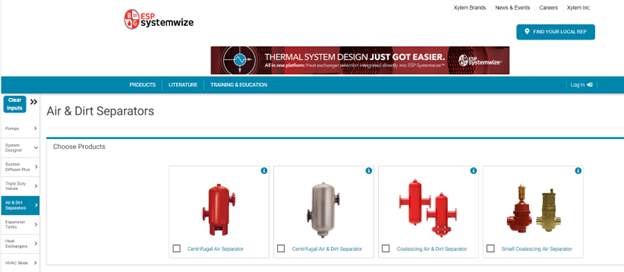 The separation of air from water in hydronic systems is critical to proper operation. Piping methods and air vents are used out in the system piping to release air from the piping system. The primary, or “Big Daddy” workhorse, is the mechanical room air separator. Today, the R. L. Deppmann Monday Morning Minutes looks at the selection and application of air separators.
The separation of air from water in hydronic systems is critical to proper operation. Piping methods and air vents are used out in the system piping to release air from the piping system. The primary, or “Big Daddy” workhorse, is the mechanical room air separator. Today, the R. L. Deppmann Monday Morning Minutes looks at the selection and application of air separators.
What is an Air Separator?
Over years, the R. L. Deppmann Monday Morning Minutes has joked about the marketing names in our industry. Just reverse the name and it will tell you what it does. An air separator is a mechanical device that “separates air” from the water. Pretty simple but important.
The Best Place to Separate Air
Last week we looked at Air Control in Closed Hydronic Systems: Part 1 – 10 Ways to Control Air in Hydronics. We provided a chart from Bell & Gossett which is shown below. It may be confusing without a complete explanation, but it simply indicates that air wants to stay in the water at lower temperatures and higher pressures. So, if I want the water to release its air, I should look at the highest temperature and lowest pressure. That location is near the boiler supply and before the pump raises the pressure. That is why we start in the mechanical equipment or boiler room.
Visit the Bell & Gossett air control technical manual TEH-1196C and Air Separator Location in Hydronic Systems for more information.
Air Separation Started with the Boiler
The place closest to the boiler and on the pump’s suction is the boiler itself. The first air separators were dip tubes in the boiler. The information above was from a B&G catalog from the 1960’s. This product allowed the water in the boiler to flow to the pump through the copper tube. Above the tube, the released air would rise and flow through the side opening to the compression tank in an air control system.
Early Air Separators
Bell & Gossett (B&G) introduced the early, stand-alone air separators as hydronic heating systems became larger. The early air separators were a large tank in the piping system. The B&G IAF inline air fitting functioned on the principle that entrained air releases when the velocity drops below 2 feet per second and even better at ½ foot per second. Once again, the air funneled to the compression tank. Some of these are still available on residential systems such as the Bell & Gossett Inline Air Separator – IAS.
Good engineering practice continues to use this principle when the system uses a boiler buffer tank. Visit more at Hydronic Condensing Boiler Heating Buffer Tanks – Part 1 of 3 – Location.
The Rolairtrol Air Separator
The B&G Rolairtrol air separator introduces a dynamic feature to air separation. It functions with a two-fold attack on air. First, it uses the reduced velocity principle mentioned above. Second, it combines that with the principle that air is lighter than water. Water enters this device through tangential openings. It swirls the water around from the top to the bottom of the tank. The lighter water moves to the center of the tank. The lighter air rises and is vented. Another benefit of strainer models is the heavier dirt is removed.
The selection of this air separator is simple. Pick the model based on the system maximum flow rate first. Now try to match your pipe size. Do not just match the flowrate without verifying your flow rate does not exceed the products maximum flow. You will find the models with strainers (R) have a lower maximum flow rate than units without the strainer (RL). You will also find that the models will normally be available in your selected pipe size if you used the ASHRAE 90.1 energy standard maximum flow rate for 4400-hour operation or more. Example: 680 GPM is the ASHRAE maximum for 6” pipe. The model R-6 Rolairtrol is good for 700 GPM.
A quick way to select them is to use the B&G ESP Systemwize program. You may select a Rolairtrol air separator or an air and dirt separator which will be the subject next week.









